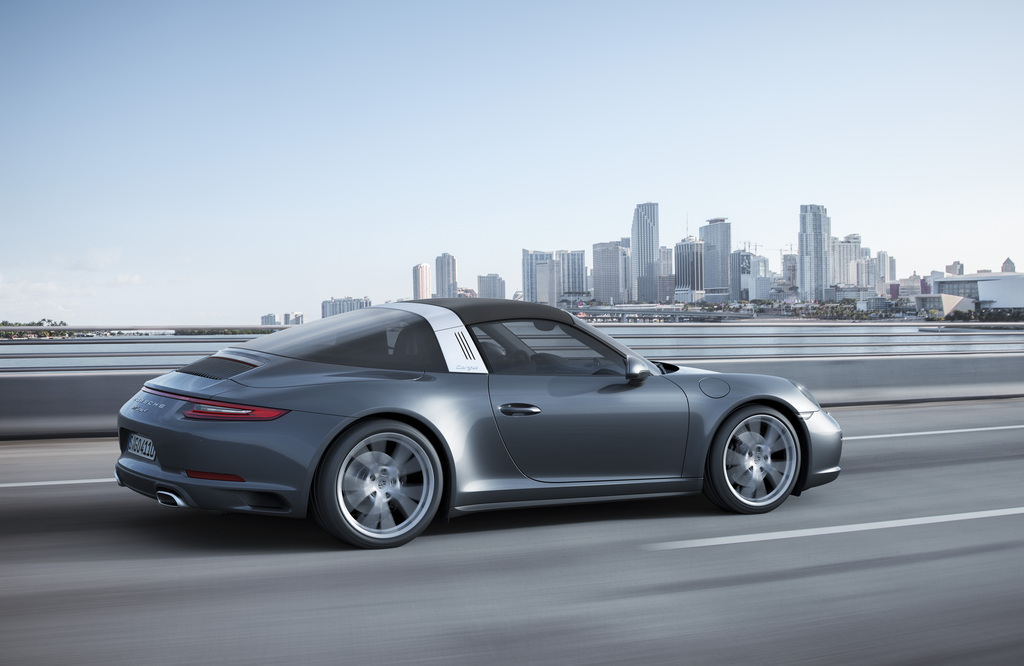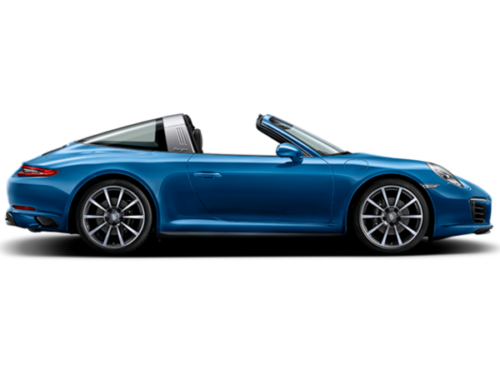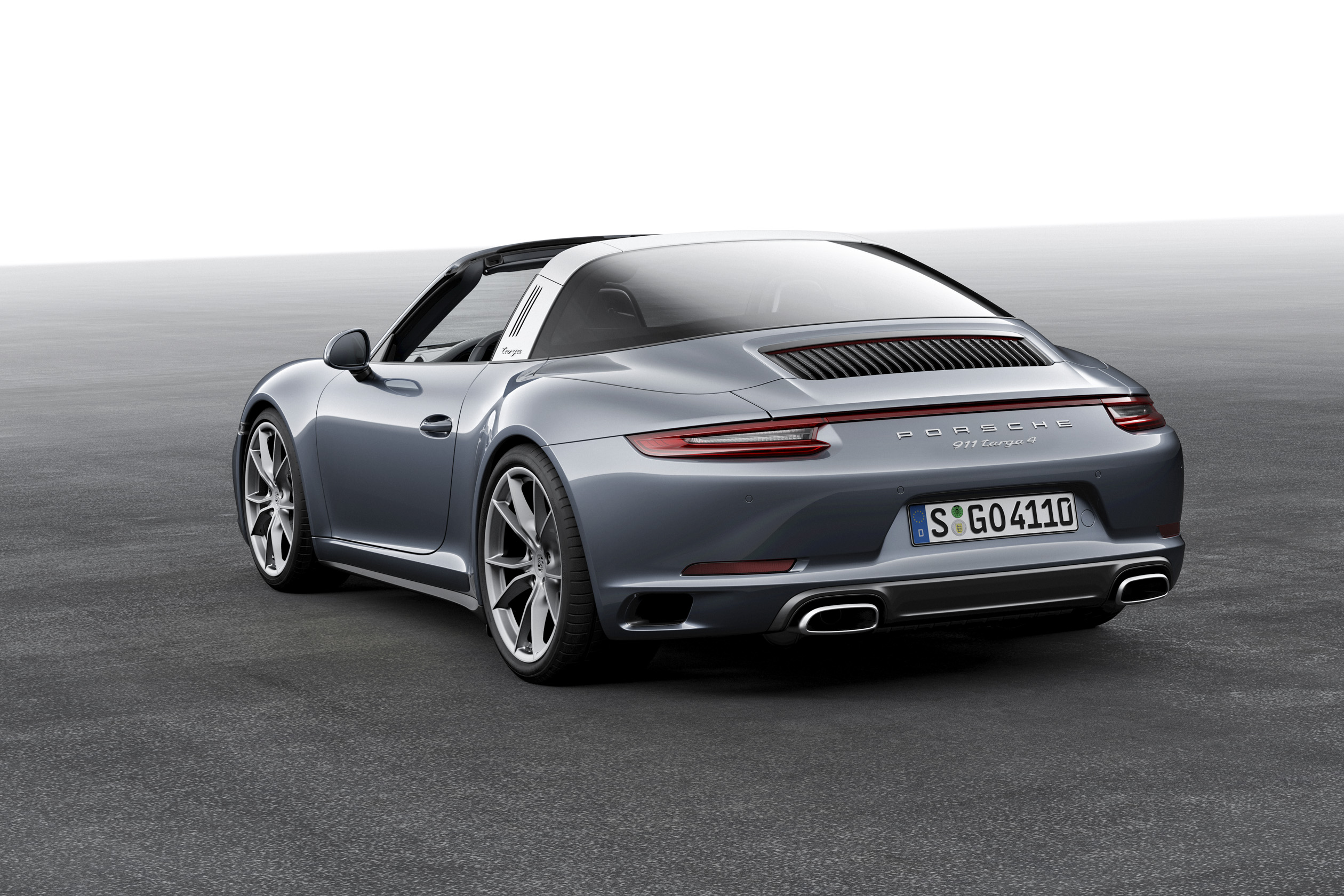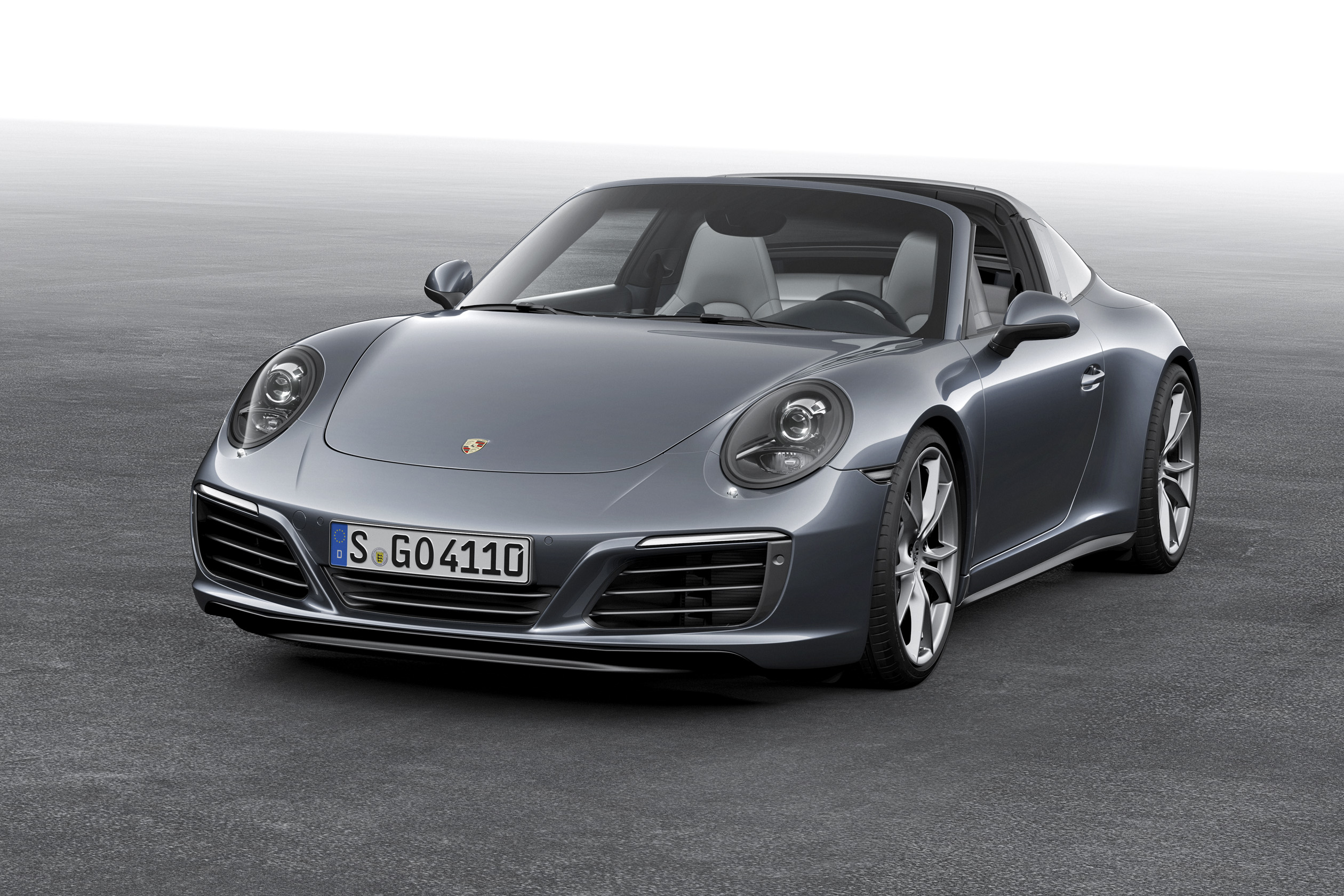(2016 – 2019) Porsche 911 Targa 4 (991.2) – Ultimate Guide
The 991.1 Targa released in 2014 brought back the original Targa concept, albeit with an even sexier design and some very cool technical tricks to boot. Porsche wanted to resurrect its classic design, but the company feared that owners would not want to get out of the car, lift off the roof panel, and stow it in the trunk. The other issue was, in the words of 911 product line director Dr. Erhard Mossle, “that the manual solution was a little bit old-fashioned.” So the Targa not only got a sexy looking original Targa look, but also got automation that was quite theatrical in operation.
The rear window and the body panel it sits on tilt up and rearward; meanwhile, the top, which like the Cabriolet’s consists of fabric-covered magnesium panels, moves backward over the brushed aluminum hoop, folds in on itself, and tucks into a tray at the base of the rear glass. The rear window and body panel then return to position. Unlike the Cabriolet, whose power top can be raised or lowered while on the move, the Targa must be stationary to perform its mechanical ballet. The whole operation takes nineteen seconds. With the 991.2 Targa released as a 2016 model year car, the fancy roof mechanism stayed and with it, the Targa 4 bodystyle was easily the sexiest of the Porsche 911 lineup.
The 991.2 Targa did get some mild design changes, but they are all inline with the rest of the 991.2 changes. Despite the mild styling revisions, it’s a dramatically different car in terms of its engine. The iconic and highly regarded naturally aspirated 3.4-litre flat-six engine has been ousted for a more environmentally friendly twin-turbocharged 3.0-litre. It keeps its all-wheel drive system and is still an all-weather 911.
A sports car with all-wheel drive is the first choice for more than one in three Porsche 911 buyers. With the new 911 Targa 4, they now profit from an increase in sporting characteristics and comfort in the latest 911 generation: the innovative turbocharged engines are more powerful and consume less, with the improved all-wheel drive increasing dynamics and driving safety. In addition, the adaptive PASM chassis (Porsche Active Suspension Management) with its ten-millimetre lower ride height included as standard enables an even greater spread between sporty circuit and relaxed long-distance driving. Rear-axle steering that is available as an option for the Carrera 4S models further increases the dynamic spectrum considerably. Interior functionality is enhanced by the standard-feature Porsche Communication (PCM) connectivity and infotainment system with simplified operation and multi-touch display.
The all-wheel drive models not only include the numerous optical refinements of the new 911 Carrera generation but also have their own individual distinguishing characteristics. For instance, the light strip between the rear lights now produces an especially distinctive effect thanks to its consciously three-dimensional design. When switched on, the light reinforces the impression of depth. The light strip also underlines the typical format of the all-wheel drive 911, with rear wings that arch further outwards by 44 millimetres in total, as in previous models. Additional distinguishing features of the new 911 generation range from the headlights with four-point daytime running lights, via door handles without recess covers, to the redesigned rear lid with vertical louvres and new rear lights – including the characteristic four-point brake lights.
Pictures
Press Release
A sports car with all-wheel drive is the first choice for more than one in three Porsche 911 buyers. With the new 911 Carrera 4 and 911 Targa 4, they now profit from an increase in sporting characteristics and comfort in the latest 911 generation: the innovative turbocharged engines are more powerful and consume less, with the improved all-wheel drive increasing dynamics and driving safety. In addition, the adaptive PASM chassis (Porsche Active Suspension Management) with its ten-millimetre lower ride height included as standard enables an even greater spread between sporty circuit and relaxed long-distance driving. Rear-axle steering that is available as an option for the Carrera 4S models further increases the dynamic spectrum considerably. Interior functionality is enhanced by the standard-feature Porsche Communication (PCM) connectivity and infotainment system with simplified operation and multi-touch display.
The all-wheel drive models not only include the numerous optical refinements of the new 911 Carrera generation but also have their own individual distinguishing characteristics. For instance, the light strip between the rear lights now produces an especially distinctive effect thanks to its consciously three-dimensional design. When switched on, the light reinforces the impression of depth. The light strip also underlines the typical format of the all-wheel drive 911, with rear wings that arch further outwards by 44 millimetres in total, as in previous models. Additional distinguishing features of the new 911 generation range from the headlights with four-point daytime running lights, via door handles without recess covers, to the redesigned rear lid with vertical louvres and new rear lights – including the characteristic four-point brake lights.
New developments in the visual appearance also underline the sophisticated elegance of the 911 Targa. With its individual design, the new 911 Targa continues to stand out clearly from the coupé and cabriolet. It spectacularly combines the classic Targa idea with advanced roof convenience. Like the legendary original Targa, it has the characteristic wide bar in place of B pillars, a removable roof section over the front seats and a wrap-around rear window without C pillars. The roof segment can be opened and closed at the push of a button, with the soft top being accommodated behind the rear seats as it opens.
Faster sprinting with up to twelve per cent less fuel consumption
Behind the re-engineered flat engines are more than four decades of Porsche experience with turbocharged engines from motor racing and production sports car. The result is that all new 911 Carrera models impress with top values in terms of performance, driving fun and efficiency. Thanks to bi-turbocharging, the three-litre, six-cylinder engines in the 911 Carrera 4 and 911 Targa 4 achieve an output of 370 hp (272 kW) and a torque of 450 Nm, while output in the S models increases to 420 hp (309 kW) and torque to 500 Nm. This gives the driver an added bonus of 20 hp (15 kW) of dynamic performance to convert into driving fun. The greater power of the Carrera S models comes from turbochargers with modified compressors, a specific exhaust system and tuned engine management.
In combination with the now electro-hydraulically controlled all-wheel drive, the 911 Carrera 4 for the first time even achieves better acceleration values than its rear-wheel-drive counterparts. Equipped with the options of PDK and Sport Chrono package, the 911 Carrera 4 sprints from zero to 100 km/h in 4.1 seconds (0.4 seconds less than its predecessor model), with the S model registering 3.8 seconds (0.3 seconds less). The cabriolet S and the 911 Targa 4 with comparable equipment need just 0.2 seconds longer – the time it takes to blink. Top speeds vary according to model and equipment between 287 km/h and 305 km/h.
Traditionally, every new generation of engines from Porsche combines more output with less consumption. Consequently, fuel consumption in the 911 Carrera 4 Cabriolet with PDK drops by 0.8 litres to 7.9 l/100 km. The models with the most significant improvements are the 911 Carrera S Cabriolet and 911 Targa 4S, each with PDK, in which average consumption falls by 1.2 litres to 8.0 l/100km.
Inherited from the 918 Spyder: Sport Chrono package with mode switch
In conjunction with the optional Sport Chrono Package, the new 911 models now have a mode switch on the steering wheel for the first time, which has been derived from the 918 Spyder hybrid supercar. The mode switch consists of a rotary ring with four positions for the driving modes “Normal”, “Sport”, “Sport Plus” and “Individual”. Using the latter setting, drivers can configure their own individual vehicle set-up, allowing them to adjust, for example, PASM, active engine mounts, PDK shifting strategy and sports exhaust system if fitted. In combination with the PDK transmission, the mode switch has an additional control, called the “Sport Response Button”. When this button is pressed, the drivetrain is pre-conditioned for maximum acceleration for 20 seconds, for example in order to carry out overtaking manoeuvres. For this purpose, the optimum gear is engaged and the engine management adjusted to an even more spontaneous response for a short time.
Re-engineered PASM chassis with ten millimetre lower ride height as standard
A Porsche 911 with all-wheel drive stands for the commendable combination of traction and driving safety with sporty driving performance. In this new generation, Porsche reconciles these contrasts even further. Firstly, the electro-hydraulically controlled all-wheel drive responds with even more speed and sensitivity thanks to the technology adopted from the 911 Turbo. This especially enhances directional stability during extremely sporty driving without sacrificing any agility. Harmony between the re-engineered all-wheel drive and the retuned PASM chassis with its ten-millimetre lower ride height is thus even better. It is fitted as standard to all Carrera models and increases stability during fast cornering. At the same time, the new shock absorber generation with its wider spread characteristics enhances comfort thanks to its even more refined responsiveness, yet it also improves car body control during dynamic driving.
The active rear-axle steering that is available as an option for the Carrera S marks the adoption of chassis technology from the 911 Turbo and 911 GT3. It increases the turn-in agility of the 911. In addition, it leads to even higher driving stability when changing lanes at high speeds. At the same time, it ensures greater manoeuvrability in city traffic thanks to the 0.4-metre reduction in turning circle. The improved handling is transmitted to the driver via the new steering wheel generation with a design based on that found in the 918 Spyder. The basic steering wheel has a diameter of 375 millimetres; the optional GT sports steering wheel measures 360 millimetres. For unlimited everyday practicality, Porsche supplies a hydraulic lift system with integrated lifting cylinders in the struts of the front axle. Pressing a button increases the ground clearance at the front spoiler lip by 40 millimetres within five seconds and thus prevents the vehicle underbody from hitting the ground, such as when negotiating steep garage exits.
Connectivity and infotainment system: PCM with multi-touch display and new functions
The completely new PCM connectivity and infotainment system included as a standard feature integrates new functions around the multi-touch display in the centre console that now has a seven-inch format. Also fitted as standard, the navigation system can be operated like a smartphone and can even process handwritten input. Drivers can access real-time traffic information, which allows them to gain an overview of the traffic situation in their area and on their route. In addition, mobile phones and smartphones can now be integrated more quickly, easily and extensively than before via Wi-Fi, Bluetooth or cable. This means that both vehicle-related services such as remote retrieval of vehicle data and also Internet-based services such as Google Street View and Internet radio are available. These services are being constantly expanded and improved.
The new Porsche 911 Carrera 4 and 911 Targa 4 will be launched in Germany as from the end of January 2016 at the following prices including VAT and country-specific equipment:
911 Carrera 4 103,983 euros
911 Carrera 4S 118,144 euros
911 Carrera 4 Cabriolet 117,073 euros
911 Carrera 4S Cabriolet 131,234 euros
911 Targa 4 117,073 euros
911 Targa 4S 131,234 euros















